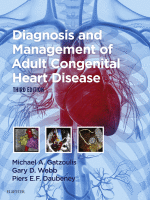Physical Address
304 North Cardinal St.
Dorchester Center, MA 02124

General Overview Pulmonary atresia (PA), or absence of a communication between the right ventricle (RV) and the main pulmonary artery (MPA), exists in two forms based on the presence or absence of a ventricular septal defect (VSD). Despite similar nomenclature,…

Definition and Morphology It was Etienne-Louis Arthur Fallot who, in a series of papers in 1888, separated the malformation we now describe with his name from other anatomic lesions responsible for the “maladie bleue.” Although autopsy cases had been recognized…

Definition and Morphology Double-chambered right ventricle (DCRV) is characterized by anomalous or hypertrophied muscle bundles, which cause a form of subvalvar right ventricular outflow tract (RVOT) obstruction, dividing the right ventricle (RV) into a high-pressure proximal chamber and a low-pressure…

Definition and Morphology Pulmonary valvular stenosis is usually an isolated congenital anomaly and occurs in 7% to 12% of patients with congenital heart disease. It can sometimes be associated with other congenital heart defects such as atrial septal defect or…

Definitions and Morphology Isolated congenital anomalies of the tricuspid valve (TV) are rare structural malformations that involve one or more components of the TV apparatus and result more commonly in tricuspid regurgitation (TR) and less often tricuspid stenosis (TS). The…

Definition and Morphology Ebstein anomaly (EA) is a rare malformation of the tricuspid valve (TV) and right ventricle (RV). The anatomic and pathophysiologic characteristics are variable and lead to a wide spectrum of clinical scenarios. The clinical presentation in adults…

The aortic arch, branch pulmonary arteries, and the ductus arteriosus have a close spatial relationship to the airways and esophagus. Abnormalities of the position or course of these vascular structures can cause obstruction to the major airways or esophagus by…

Definition and Morphology Truncus arteriosus (also known as persistent truncus arteriosus, truncus arteriosus communis, common arterial trunk, or common aorticopulmonary trunk) naturally involves a single arterial vessel exiting the base of the heart, which gives rise to the coronary, pulmonary,…

Coarctation of the Aorta Definition and Morphology Coarctation of the aorta (CoA) is a complex cardiovascular disorder, and, as part of a generalized arteriopathy, a lifelong disease that persists after treatment. It was Morgagni who, in 1760, first described CoA,…

Patent Ductus Arteriosus Embryology The patent ductus arteriosus (PDA) is a remnant of the distal left sixth aortic arch, which connects the proximal descending aorta to the main pulmonary artery near the origin of the left pulmonary artery. During fetal…